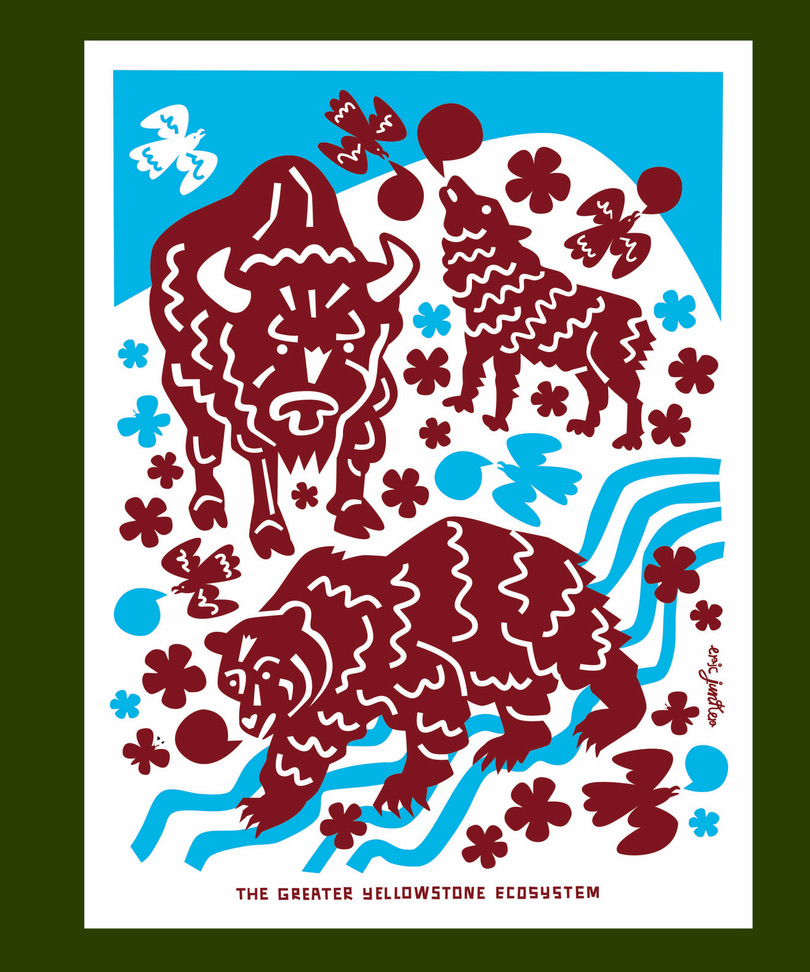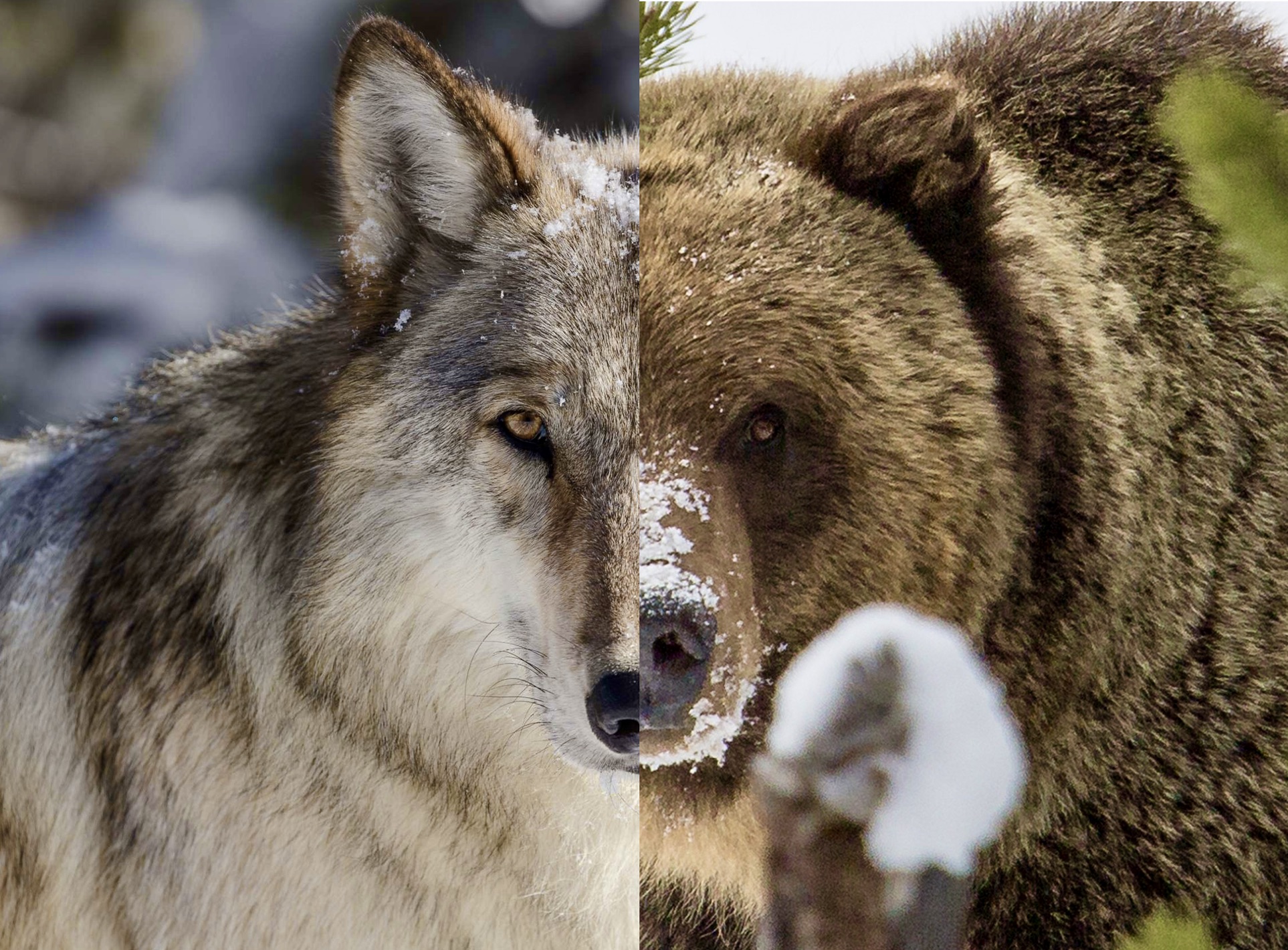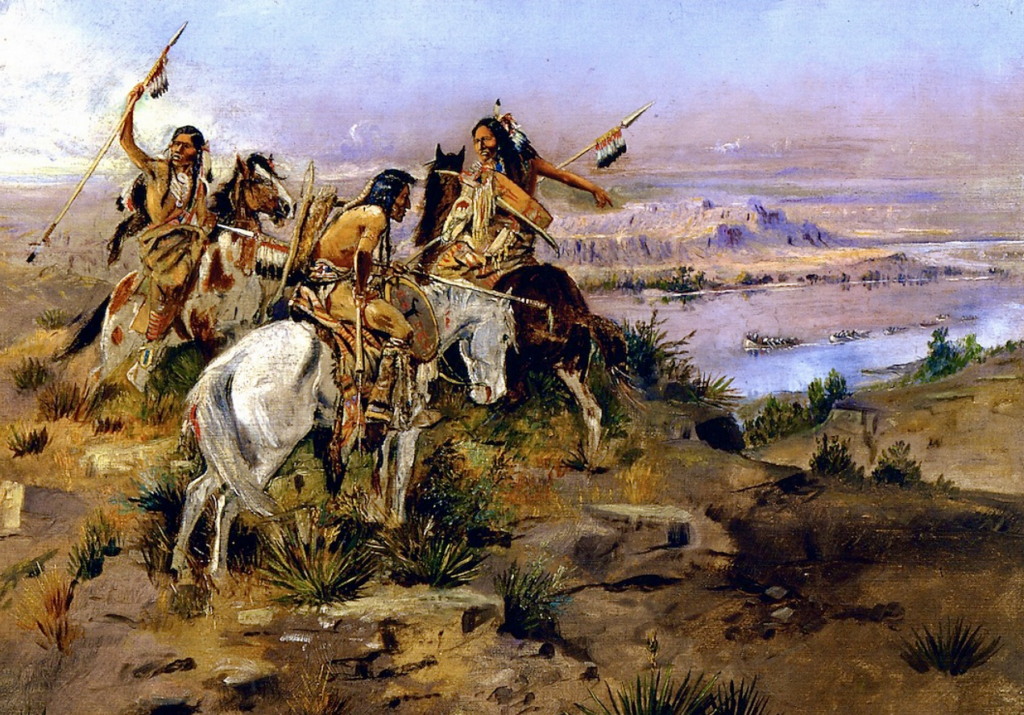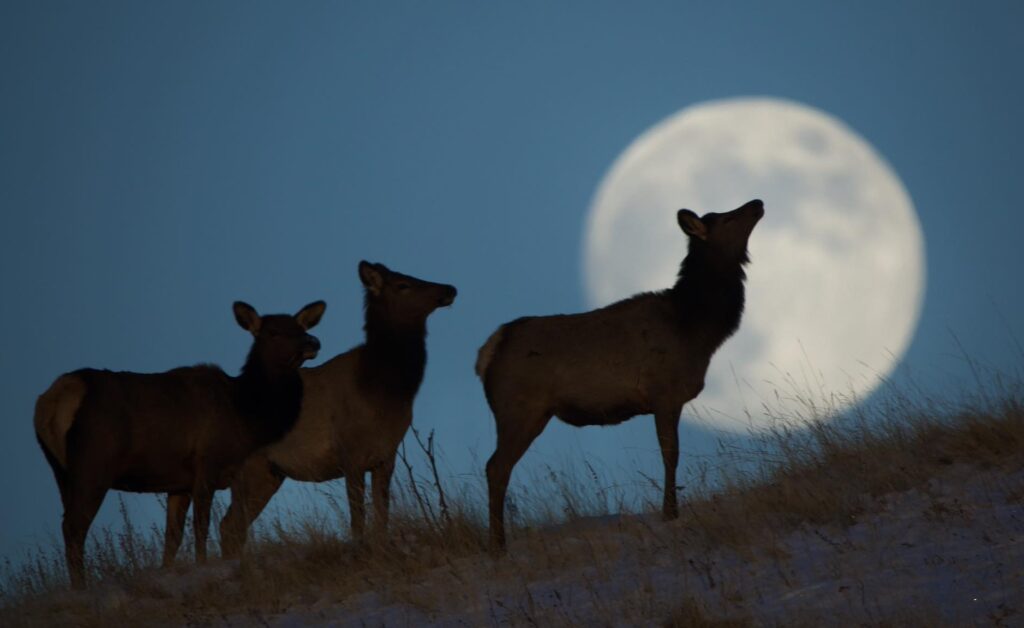EDITOR’S NOTE: If you’re a citizen who values professional stewardship of wildlife that belong to the public, and if one believes science and the public trust doctrine should guide decision-making, then it would be hard to find two people better versed in grizzly bears and wolves than Dr. Christopher Servheen and Dr. Douglas Smith. Between them they have around 85 years of field and high-profile experience advancing the conservation of Greater Yellowstone’s two most iconic species and animals closely identified with what we called the true wild West.
For four decades, Servheen was involved with reviving the fortunes of grizzlies in the Northern Rockies, 35 of those years spent as national grizzly bear recovery coordinator for the US Fish and Wildlife Service. For roughly the same amount of time, Smith was involved with wolf management in the Upper Midwest and then became chief wolf scientist in Yellowstone National Park. Today, both are retired from government service and they allowed to speak more candidly about the status of both species and what trend-lines suggest for their future. Grizzly and wolf recovery have been hailed as two of the greatest wildlife comebacks in the history of conservation. In this essay written for Yellowstonian, they share their thoughts below. Note: Yellowstonian will be hosting both of these esteemed big picture thinkers at a pair of events in Bozeman and Missoula in October. —Todd Wilkinson, Yellowtonian co-founder
by Dr. Christopher Servheen and Dr. Douglas Smith
Everyone concerned about our native wildlife should be concerned that in Congress and the states of Montana, Idaho and Wyoming, politics, not biology, drives carnivore management decisions that have produced regressive policies and legislation that is both anti-carnivore and anti-science.
Present day wildlife management in the United States is respected for its world leadership and application of science-based wildlife conservation. This is a change from the past practices in the 1800s and early 1900s that allowed excessive unregulated killing of wildlife with dramatic reductions in populations of many species like bison, elk, and pronghorn, the almost complete extinction of wolves in the lower 48 states, local extinctions of fishers and wolverines and the near extinction of grizzly bears.
Modern wildlife management rectified these problems introducing regulated harvest and management of game animals as a valued resource and mostly eliminating unlimited and wanton killing of wild animals. Science-based management to restore most big game animals including carnivores and the Endangered Species Act (ESA) allowed many wildlife species to make tremendous comebacks.
Wildlife restoration success in the US was a model for the world. Now, however, recent Congressional bills to override the requirements of the Endangered Species Act and state laws in Montana, Idaho and Wyoming’s predator zone directed at reducing wolves take us back to the regressive years of the late 1800s. These laws run counter to professional wildlife management ethics and science-based wildlife management.
The US public appreciates the value of wildlife and more than 148 million Americans are involved in non-consumptive wildlife watching. As human population and habitat development pressures increase, we should be working together to improve our wildlife management practices in the 21st century, instead of regressing backward to the anti-predator policies of the past that we know to be destructive. State wildlife management policy should serve the majority of the public and not be driven by a small minority who hate predators.
Anti-carnivore legislation in Idaho, Montana and Wyoming raises substantial concerns. The Idaho legislature has directed state agencies to implement new, intensive, lethal methods to reduce wolf numbers across the state. These legislative measures could drive wolf numbers down to 150—the minimum number federally required for wolf recovery—potentially killing 90% of Idaho’s estimated 1,500 wolves. In Montana, the state legislature passed new laws and new wolf killing methods to try to reduce the state’s wolf population of approximately 1,200 wolves down to 450 or fewer. Wyoming has classified wolves as a “predatory animal” across most of the state where they currently can be killed by any method year-around without a license. It is legal to run wolves (and coyotes) down with motorized vehicles in the predatory animal area in Wyoming even on public lands (see Yellowstonian article by writer Todd Wilkinson April 2024). It is currently legal to run down most predators with snowmachines in Montana and Idaho.
Wolves have always been a special management challenge, with social carrying capacity often taking precedence over biological carrying capacity or even long-term sustainability. Due to their high reproductive rate and resulting resilience to human caused mortality, the management answer has always been high harvest rates (sometimes exceeding sustainability) and/or control (elimination of 80 to 90 percent of the population in a certain area.
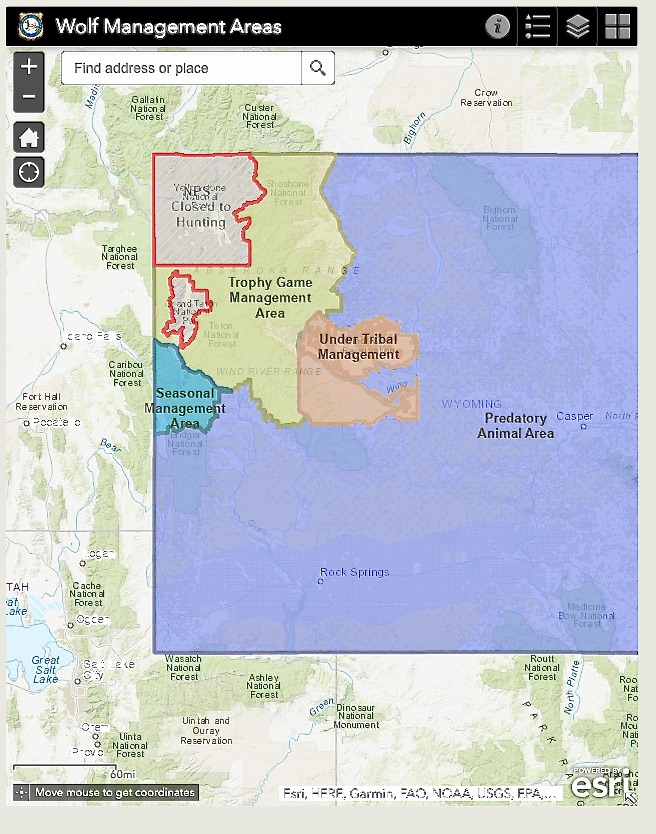
Graphic above shows Wyoming’s “Wolf Trophy Game Management Area” encompassing about 15 percent of the state. Wolf hunting is not allowed in Yellowstone and Grand Teton national parks. Beyond the northwest corner of Wyoming, wolves are not treated as a game species but de-classified to a lesser status as predators. There, in the “Predatory Animal Area” that covers 85 percent of the state, they can be legally killed 365 days a year, any hour of any day, by almost any means. Never, in the history of the Endangered Species Act, has a species deemed recovered and having its management turning over a state, been given a status like this; a status that basically allows for endless killing without professional wildlife principles being in full force, including fair chase and anti-cruelty standards. Image courtesy Wyoming Game and Fish.
The recent actions by Idaho and Montana state legislatures are even more aggressive than these long-term debated practices essentially allowing near-year-round killing by any means often supported by subsidies paid to people to try and kill wolves that are thinly veiled bounties—all regressive wildlife management policies of 1800s. These regressive policies are enacted by politicians not wildlife biologists. It is chilling when professional wildlife biologists are cut out of their professional responsibilities due to political interference. Such is the case for wolf management in Montana and Idaho today.
These state laws and the specific techniques they prescribe (see Table 1 for Montana and Idaho wolf killing methods) are notable in that they are not based on any demonstrated biological necessity and, in many cases, depart from the principles of ethical, fair chase hunting. Their legislative passage was based on emotional appeals stoked by misinformation about predators. No biological data were presented to the legislators in these states to justify them. There is no demonstrable or measurable threat from wolves to the livestock industry or to state big-game populations. For example, in Montana in 2023 wolves were responsible for 23 documented livestock losses to the 2.65 million cattle and sheep in the state while in Wyoming in 2022, wolves were responsible for the loss of 97 head of livestock.
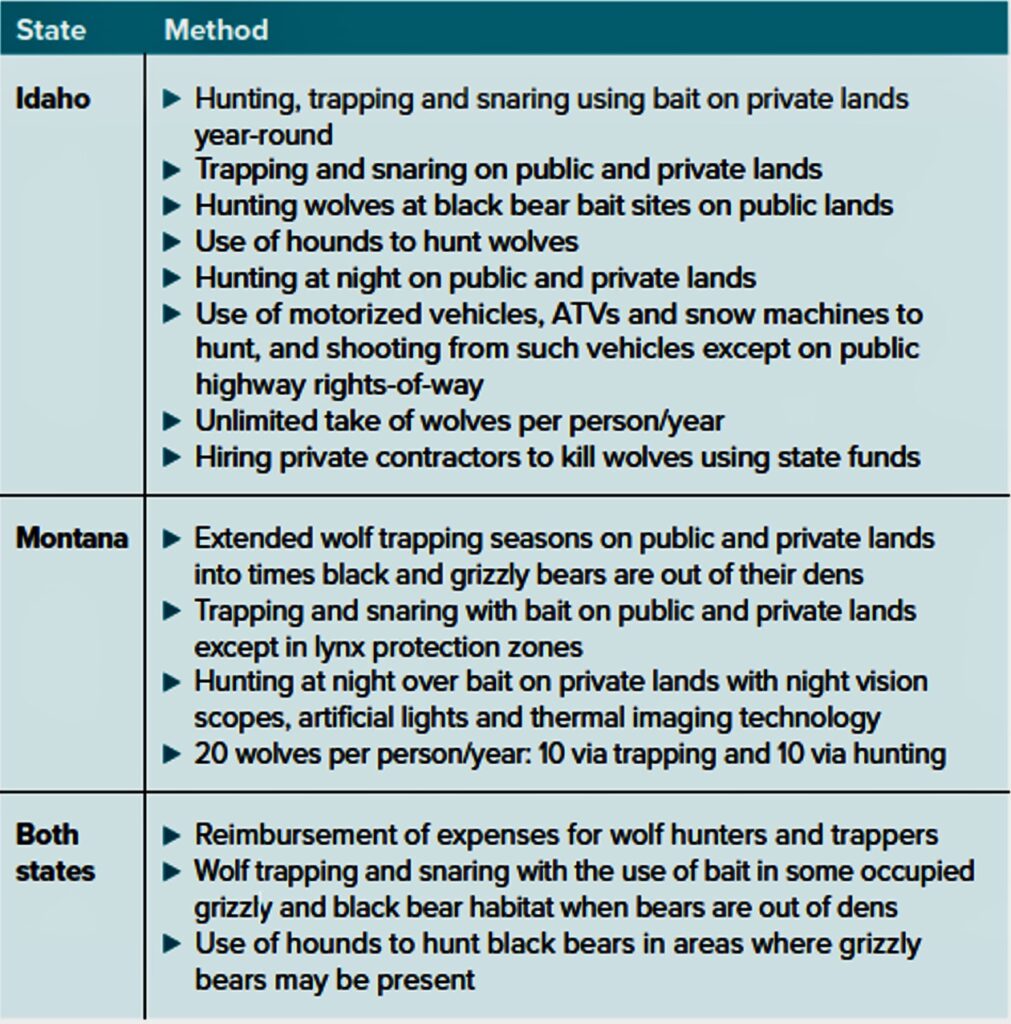
These anti-predator state laws should be of concern to wildlife professionals and the public because they replace science and fact-based wildlife management and the principles of fair chase hunting with ideology-driven legal mandates that are often not ethical. These legislatures are mandating unethical, unsportsman-like hunting and trapping techniques such as night hunting with spotlights over bait, neck snaring with bait, and paying people a bounty to try and kill wolves. The fact that state legislatures will not pass legislation to make it illegal to run down wolves, coyotes, and foxes with snowmachines, is testament to how political wildlife management has become. Such practices are not only not fair chase, but they are also unethical, inhumane, and repugnant to most citizens. As such barbaric practices become more widely publicized, they tarnish and erode the public’s trust in state government officials and wildlife professionals. This erosion of trust in state management officials will make grizzly bear delisting unlikely because the public will not trust state officials to manage grizzlies given how they are currently mismanaging wolves.
Further, killing wolves using such means is a rejection of the public trust doctrine and the concept of fair chase hunting, and such laws will have collateral and harmful impacts to all carnivore populations. Since leg-hold traps and neck snares are indiscriminate, many non-target wildlife species—particularly carnivores—will also be captured when bait is used with traps and neck snares. Non-target captures using wolf traps and neck snares with bait include many carnivores including bobcats, fishers, lynx, black bears, grizzly bears, mountain lions, wolverines and even non-carnivores like deer, elk and moose. There is likely a low level of self-reporting of such non-target captures by trappers because if the public was aware of the high numbers of non-target animals captured or injured in traps and snares, there would be pressure for limits on such trapping.
Targeting predators using unethical methods has the potential to malign the image of all hunters in the eyes of the public. Hunting of big-game animals is currently practiced by only a small proportion of the American public, and hunting depends on public acceptance and support. According to the U.S. Fish and Wildlife Service, only 4.4% of Americans hunt big-game animals as sport hunters. In Montana, there were approximately 7,000 active wolf hunters in 2022-2023, which is approximately 0.62 percent of Montana residents. The draft Montana wolf plan states there are approximately 1,700 trapping licenses issued with wolf certification, which is approximately 0.15 percent of Montana residents, and that there are approximately 250 active wolf trappers, which is approximately 0.022% of Montana residents. The number of all paid hunting license holders in Montana in 2024 was 237,339, thus active wolf hunters make up 2.94% of paid hunting license holders in Montana. Active wolf trappers make up 0.11% of paid hunting license holders in Montana. The very small proportion of wolf hunters and trappers in Montana can negatively affect the public image of the entire hunting community.
Unintended consequences
The Montana legislature extended the wolf trapping and neck snaring season into the fall and spring, when some grizzly and black bears are still out of their dens and vulnerable to capture. The state of Idaho allowed an even longer period of wolf trapping and snaring. Recently, federal courts have overturned state wolf trapping regulations and limited the time and areas where wolf trapping and snaring can occur in both Idaho and Montana based on the risk to ESA-listed grizzly bears. If grizzlies were delisted, these Federal court prohibitions on wolf trapping would disappear. Both Idaho and Montana have decried these federal court limits on wolf trapping in areas where grizzlies are present, demonstrating their minimal concern for grizzlies that would be killed or injured in such traps and snares if grizzlies were delisted.
The Montana legislature passed a law in 2021 to allow hound hunting of black bears and a hound chase season on black bears, both of which had been prohibited in Montana since 1921. This was passed despite extensive testimony in opposition by many hunting and wildlife groups and even opposition by non-hound hunting black bear hunters. Multiple surveys across many states have shown limited public support for hound hunting of black bears among big-game hunters, black bear hunters and non-hunters. The law in Montana that allows the use of hounds to hunt black bears also by default has implications for grizzlies, whose range overlaps much of the black bear range in Montana.
Hound hunting black bears anywhere in grizzly bear range is potentially deadly because of the risk of encountering a grizzly instead of a black bear. Grizzly bears typically do not run from hounds. Usually, they stand and fight, which can result in hounds being killed or injured. Such fights can occur before hound hunters arrive to attempt separate hounds from a grizzly. When hound hunters encounter an agitated grizzly killing their dogs, they will likely want to try and protect their dogs by killing the grizzly, which is illegal. Reporting is such grizzly encounters by hound hunters will be low because such encounters should result in increased limits on hound hunting.
Grizzly bears are now found in most of western Montana (see map) therefore hound hunting of black bears should be prohibited in all these areas. However, the Montana Fish and Wildlife Commission continues to allow black bear hound hunting in many areas where grizzlies are present despite repeated requests from many members of the public to curb this practice in grizzly habitat.
Are these new state laws really necessary?
Montana’s legislature passed a law allowing anyone to kill any grizzly after delisting even on public land if they were given a permit to do so to protect livestock. Killing a grizzly “threatening” livestock is illegal under federal law while the grizzly remains listed.
Another Montana law prohibits the Montana Fish, Wildlife and Parks Department from relocating any grizzly involved in conflict if it was captured outside a recovery zone. This law contravenes 40 years of cooperative management between state and federal agencies under the Interagency Grizzly Bear Guidelines, which specify that grizzly bears involved in minor conflicts or first-time offenders, particularly females with offspring, should be relocated. This law prevents the Montana wildlife agency from continuing as a functional cooperating partner agency in grizzly bear management outside recovery zones. Most importantly, this law calls into question how Montana would adequately manage grizzly bears and grizzly mortality if the grizzly bear in Montana were ever delisted.
Some of the arguments used to justify these laws are that wolf and black bear numbers need to be reduced to “save” deer and elk from predation and that wolves are a serious threat to the livestock industry. There is no evidence that these concerns are true, however. According to the Montana Department of Fish, Wildlife and Parks, Montana’s elk population was 143,310 in 2023. Elk harvest numbers have remained constant to slightly increasing since the mid-1980s.
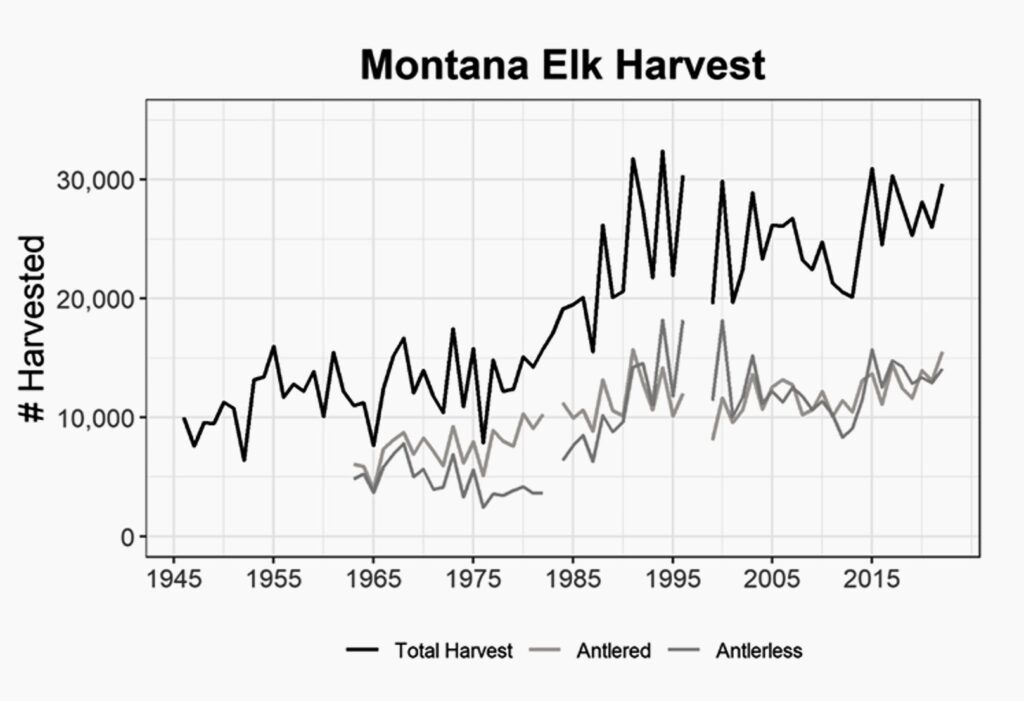
Wolf predation on livestock is low. Between 2018 and 2020, the three-year average number of cattle and sheep lost to wolves in Idaho was 113 per year or 0.00428% of the cattle and sheep in the state. In contrast, more than 40,000 cattle were lost in Idaho in 2015 (the most recent year data are available) due to weather, disease and other non-predator causes. In Montana, the three-year average was about 110 cattle and sheep lost to wolves per year—just 0.00415% of the state’s sheep and cattle. In 2023 in Montana, wolves killed 17 cattle, 6 sheep and 2 guard dogs. Livestock losses to predators are a real and valid concern because they affect people’s property and livelihood. Recognizing this, state and federal agencies already implement programs to remove depredating wolves to help reduce such losses. Livestock owners in these states also receive financial compensation for every documented loss to wolves. In Montana in 2023, livestock owners were paid $221,150 for losses due to wolves, lions, and grizzly bears.
Possible Solutions
Wolves can be managed and hunted as valued big game animals by using science and facts to set sustainable mortality limits to maintain wolves as part of functional healthy natural ecosystems, which includes wolf predation on healthy native ungulate populations. Wolf hunts should use ethical, fair-chase wolf hunting practices. There will continue to be targeted removals of any wolves involved in livestock conflicts. Across northern North America, wolves are regularly harvested and valued as a natural resource, not killed indiscriminately for no reason when their pelts are of no value – as happens now across Idaho, Montana, and Wyoming.
Montana had an annual wolf sport hunt using fair chase practices and trapping season 2009-2020, with an annual harvest of about 30% of the state-wide wolf population, although the exact harvest rate is unknown due to wide bounds and a questionable wolf population estimator used in Montana. Past wolf trapping seasons occurred during winter when bears are in their dens, so there was no overlap or potential conflict with bears. Since 2013, Montana’s wolf population declined and then stabilized at between 900 and 1,200 wolves.
Debates and decisions about the need for increased predator management to improve ungulate populations should be informed by the best available science collected and analyzed by state agency wildlife management experts. However, such decisions are rarely clear or satisfying to all involved. This is even more so when the public’s attention has been drawn to wolves as a demon species, and the “culprit” and misinformation rather than science is the point of reference. The explanation of the dynamics of natural systems is rarely as cut and dried as the public would like. This complexity is captured in a 2020 Montana report evaluating carnivore harvest as a tool for increasing elk calf survival and recruitment: “The connection between predator harvest, predator population dynamics and predation risk to ungulates is unclear and has rarely been evaluated,” the authors wrote. “This lack of clarity is worsened where predator harvest regulations are set in response to a combination of social, biological and political factors.”
Much to lose
It is important to realize that the Endangered Species Act requires more than just numbers of animals to achieve recovery and delisting.In addition to reaching the numerical goals of recovery, there must be adequate regulatory mechanisms in place to assure that necessary habitat remains available and adequate regulatory mechanisms in place to control mortality to sustainable levels.
The current efforts by state legislatures to drive the numbers of wolves down to minimum numbers based on anti-predator animosity using unethical and unsportsmanlike means is not a demonstration that adequate mortality mechanisms are in place. In retrospect, given the baseless anti-wolf legislation and policies from state politicians, it may well be that the minimum wolf numbers required under delisted status were set too low. Currently the states can drive wolf numbers down to as few as 100 wolves or 10 breeding pairs in each state of Montana, Idaho, or Wyoming in any one year, or down to 150 wolves or 15 breeding pairs in any of the states for three consecutive years and still avoid relisting. Setting such minimal wolf numbers for recovered status is unwise in this time of anti-science political animosity combined with climate change uncertainly.
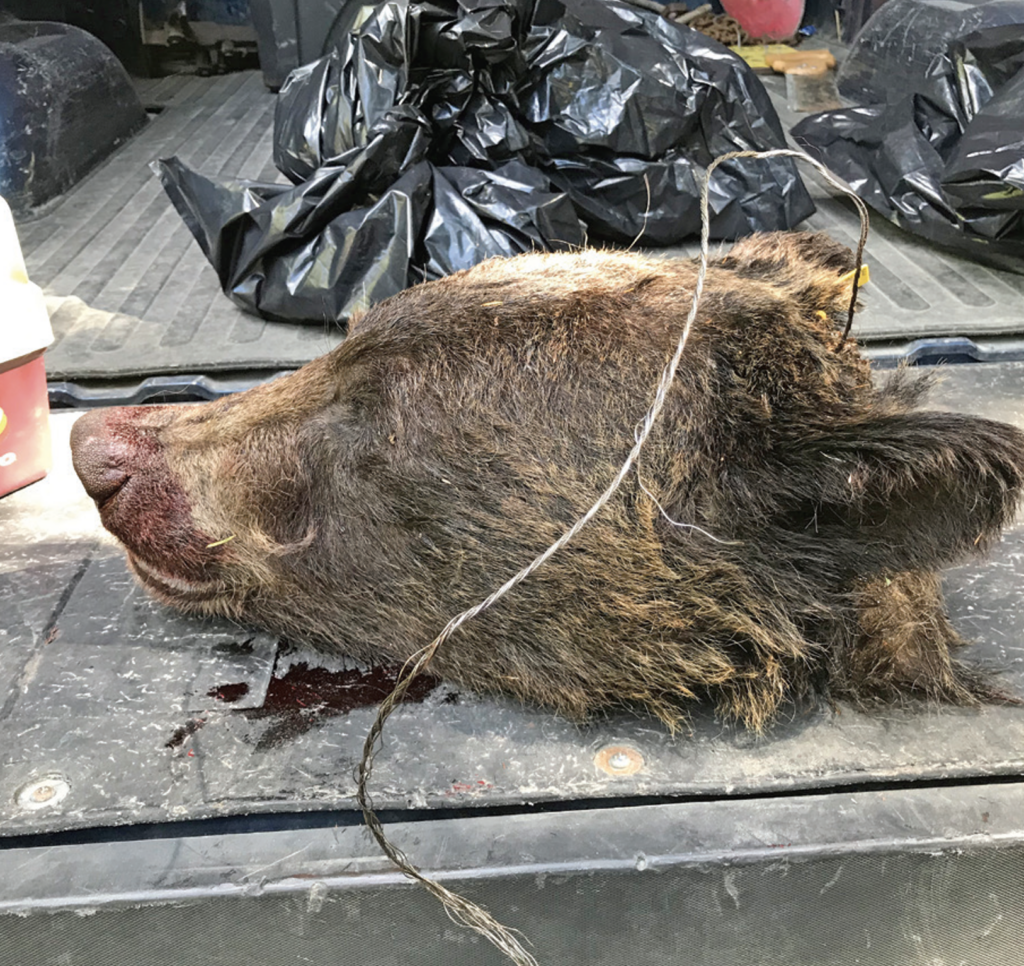
The main targets of politicians have been wolves, but there is also serious risk to grizzly bears. There have been several Congressional bills introduced to Congressionally delist grizzly bears by ignoring the requirements of the Endangered Species Act in 2023. Read the testimony delivered in person. Many of the wolf killing methods proposed by states such as neck snaring and trapping with bait while bears are still out of their dens, hound hunting of black bears in grizzly range, and furbearer trapping in grizzly habitat also risk killing and injuring grizzlies. If one wants to learn more about the dangers, read this recent guest essay in Yellowstonian from a predator control expert in Canada about how grizzlies and other animals got caught and killed in snares set out for wolves.
One more thing we wish to point out is that the lessons of successful management that has occurred with grizzly bears being listed these past 49 years grizzly bears can be applied to other areas where bears have been absent but can roam again. Those places are the Bitterroot Mountains, which represent a key area of biological linkage between Greater Yellowstone and the Northern Continental Divide Ecosystem, Cabinet-Yaak and Selkirks; and the rugged area in and around North Cascades National Park. Fostering the best possible conditions for this to happen represents a continuation of true biological recovery of the species and will better the prospects of a grizzly population in the West being more resilient to dealing with widespread habitat loss occurring on private lands and the yet fully known impacts of climate change.
We’ve made so much positive progress and we’ve shown the world how co-existence can work with grizzly bears. Citizens ought to be mightily proud of what has been accomplished but now they need to insist that antiquated attitudes of the past not prevail again. Montana produced a draft grizzly bear management plan in 2022 that was criticized as a grizzly hunting plan to reduce numbers and range upon delisting instead of a real grizzly management plan the continues species recovery. The draft Montana plan contained little information on ways to reduce human-bear conflicts to prevent grizzly mortalities. Instead, it promoted intolerance, including killing of non-conflict bears, even females with cubs, when they were found in areas deemed unacceptable to state politicians, even on public land. As of June 2024, it has been 18 months since this draft was released and it is yet to be finalized, which is ominous as to what Montana’s intentions are.
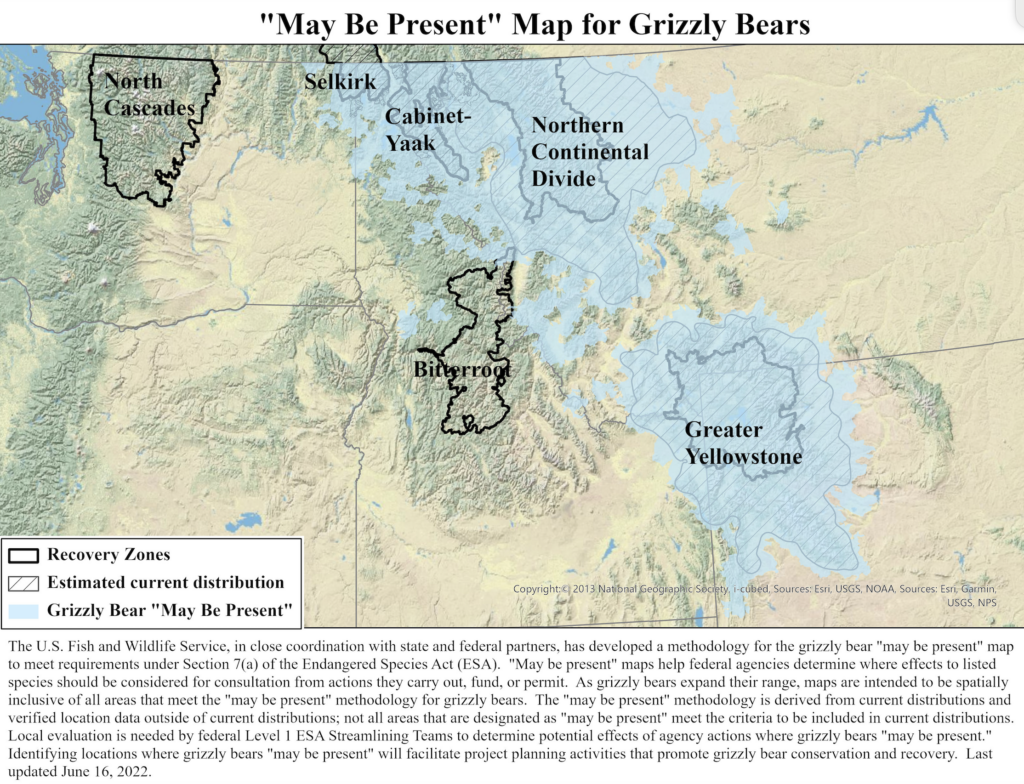
Montana continues to promote misinformation about the effects of hunting on grizzly bears as in this state regulation: 12.9.1401 (1)(C)(ii): “Sport hunting is considered the most desirable method of balancing grizzly bear numbers with their available habitat, minimizing depredations against private property within or adjacent to grizzly bear habitat, and minimizing grizzly bear attacks on humans.”
None of the statements in this policy are true. Sport hunting will not balance grizzly bear numbers with their available habitat because sport hunting, if managed as a sustainable hunt, should involve so few bears that it would not appreciably reduce the total numbers of bears on the landscape. Grizzly bears exhibit density-dependent population regulation where cub survival and reproductive transition (females having no offspring transitioning to having cubs) are negatively related to bear density. This means that increasing grizzly numbers and density results in lower grizzly population increase.
Sport hunting, contrary to assertions, will not minimize depredations against private property or human/bear conflicts within or adjacent to grizzly bear habitat. The idea that sport hunting will minimize depredations against private property is supported neither by facts nor science and is contrary to the published scientific literature on the relationship between sport hunting bears and human-bear conflicts. Hunting of bears has been documented in the peer-reviewed scientific literature to not reduce human-bear conflicts as published by researchers who found: “Human-bear conflict was not correlated with prior harvests, providing no evidence that larger harvests reduced subsequent human-bear conflicts. Given that variation in natural foods, harvest is unlikely to prevent elevated levels of human-bear conflicts in years of food shortage unless it maintains bears at low densities – an objective that might conflict with maintaining viable populations and providing opportunities for sport harvest.”
Another recent study also demonstrated that sport hunting of bears did not reduce human-bear conflicts even though bear harvest increased significantly. The authors stated: “Human–bear interactions, incidents, and harvest were strongly related to the availability of natural foods in all analyses. Regulated, presumably sustainable harvest was ineffective at reducing human–bear interactions and incidents in the near‐term and might have increased both. Our results support a long history of research showing that natural food availability is a primary driver of human–wildlife conflict. Programs promoting coexistence between people and wildlife, including education, capacity building, and management of unnatural food sources are likely to be the most successful at reducing conflicts between people and bears.”
Sport hunting does not “teach” bears to avoid people because bears killed by hunters do not “learn” anything. Nor will sport hunting, contrary to assertions, minimize depredations against private property or human/bear conflicts within or adjacent to grizzly bear habitat.
Sport hunting also will not minimize grizzly bear attacks on humans nor will sport hunting make grizzly bears “wary” of humans. Most grizzly bear attacks on humans are due to random surprise encounters between bears and humans, or to bears that have become food conditioned to human-related foods such as garbage and spend time near human dwellings. Sport hunting a limited number of grizzlies each year will not reduce the possibility of a surprise encounter between a bear and a human over thousands square miles of grizzly range. Sport hunting of grizzly bears will not occur around garbage containers or near homes or buildings where humans and garbage-conditioned bears have a higher opportunity to encounter each other. Sport hunting does not “teach” bears to avoid people because bears killed by hunters do not “learn” anything. Bears are solitary animals except for family groups of females with their young, which are not legal to hunt. The death of a bear from sport hunting has no connection to the behavior of other bears and sport hunting will not change the behavior of bears that are not shot during sport hunts.
Idaho has no grizzly management plan but, in the fall of 2022, Idaho authorities killed an adult female grizzly and her two cubs near Tetonia, Idaho even though they were not in any conflicts with people or livestock. This caused a pushback among local Tetonia and Driggs, Idaho residents who saw this as a worrying indication of how Idaho would treat grizzlies if they were ever delisted. Idaho has allowed neck snaring and trapping for wolves in places where grizzly bears are present, but this was recently blocked by a Federal Judge in response to a lawsuit. Idaho continues to allow hound hunting of black bears where grizzly bears are present.
In the fall of 2022, Idaho authorities killed an adult female grizzly and her two cubs near Tetonia, Idaho even though they were not in any conflicts with people or livestock. This caused a pushback among local Tetonia and Driggs, Idaho residents who saw this as a worrying indication of how Idaho would treat grizzlies if they were ever delisted
Wyoming does not classify grizzly bears as predatory animals as they do wolves in much of the state (see map). If grizzlies were delisted, there would be less tolerance for grizzlies outside the area where grizzlies will be monitored called the demographic monitoring area (DMA). The level of political acceptance for grizzlies outside the DMA post-delisting is unknown, and, at least at present, grizzlies will be managed as a trophy game animal in Wyoming unlike the predatory animal status for wolves,
Why this matters
Wolves and grizzly bears were listed in the 1970s under the Endangered Species Act (ESA) largely because past aggressive anti-predator management policies in the Lower 48 U.S. states. It took the ESA, cooperative conservation efforts and careful management of mortalities and habitat over the past 40 years by state, federal and tribal agencies, with the support of the public, to successfully recover wolf and grizzly bear populations in many areas of the Northern Rockies. These cooperative, transboundary, science-based efforts have helped to heal the damage done to natural ecosystems in the Northern Rockies by the anti-predator focus of the past. All the work, funding and success of these wolf and grizzly bear recovery programs is now threatened by the current anti-wolf political focus in certain states, which may reverse all the gains that have been made. The state legislatures in Montana and Idaho have taken over the management of wolves and to some extent grizzly bears. Decisions on the harvest levels and methods used to kill these animals are now made by politicians and not by biologists.
If anti-carnivore legislation continues, we stand to lose much more than healthy carnivore populations. These anti-predator laws threaten the very foundation of scientific wildlife management as well as the acceptance of hunting as a legitimate and non-political management tool. If state politicians are going to ignore science-based wildlife management and prescribe how many predators should be killed and the specific methods to be used to kill them, it will be difficult to ever manage most carnivore populations sustainably, realistically complete grizzly bear recovery, and ever have in place the adequate state regulatory mechanisms necessary for state agencies to credibly manage recovered grizzly bears and wolves using science and facts.
Recent anti-carnivore policies in Montana and Idaho are based on an abnormal hatred of carnivores that is not reasonable, and not based on anything other than the anti-predator altitudes of the 1800s. These state policies toward carnivores have no place in modern day, science and fact-based wildlife management.
The public needs to speak up about the detrimental aspects of political management of wolves and grizzly bears. It is the responsibility of politicians to avoid vengeance management of carnivores based on the extreme opinions of a minority of their constituents. State agencies should instead carefully manage all native wildlife species on behalf of all citizens, not just those who dislike predators. Carnivores have always presented management challenges. However, the historic reasons for carnivore conflicts (livestock, game populations, human safety) have been addressed with active agency removals of carnivores in conflicts.
Recent anti-carnivore policies in Montana and Idaho are based on an abnormal hatred of carnivores that is not reasonable, and not based on anything other than the anti-predator altitudes of the 1800s. These state policies toward carnivores have no place in modern day, science and fact-based wildlife management. If we are to maintain healthy wolf and grizzly populations in the future, we must manage them using science and facts applied in a professional manner and refined through a balanced and fair public process.
Support Yellowstonian and
Get Some Real Cool Visual Stuff
From now through the end of July, Livingston-based Artemis Institute, the parent non profit entity of Yellowstonian, is participating in the Park County, Montana Community Foundation’s Give a Hoot fundraiser and all contributions made to Artemis Institute will support Yellowstonian‘s mission of providing conservation journalism focused on Greater Yellowstone. We would be profoundly grateful for your support and here’s your chance to get a really cool visual reward for your generosity: Anyone who contributes $35 or more will receive their pick of one individual species poster below or all three for $100. For a donation of $350 or more, supporters will receive a special, limited-edition collector’s lithograph that features all three of Greater Yellowstone’ species’s icons. It is hand-signed by Eric Junker.
